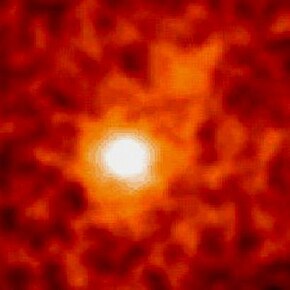| 3C 279 | |
|---|---|
 | |
| Observation data (J2000 epoch) | |
| Constellation | Virgo |
| Right ascension | 12h 56m 11.1s[1] |
| Declination | −05° 47′ 22″[1] |
| Redshift | 0.5362 ± 0.0004[1] |
| Distance | 5.0 Gly |
| Apparent magnitude (V) | 17.8[1] |
| Other designations | |
| 3C279, 4C –05.55, NRAO 413, PKS 1253–05 | |
3C 279 (also known as 4C–05.55, NRAO 413, and PKS 1253–05) is an optically violent variable quasar (OVV), which is known in the astronomical community for its variations in the visible, radio and x-ray bands.[2] The quasar was observed to have undergone a period of extreme activity from 1987 until 1991.[3] The Rosemary Hill Observatory (RHO) started observing 3C 279 in 1971,[3] the object was further observed by the Compton Gamma Ray Observatory in 1991, when it was unexpectedly discovered to be one of the brightest gamma ray objects in the sky.[4] It is also one of the brightest and most variable sources in the gamma ray sky monitored by the Fermi Gamma-ray Space Telescope. It was used as a calibrator source for Event Horizon Telescope observations of M87* that resulted in the first image of a black hole.[5]

